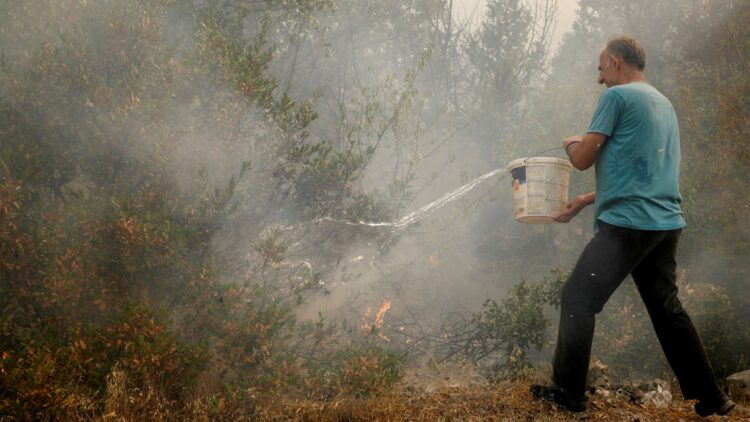This year, Europe has suffered from extreme heat waves, which have led to forest fires, fueled by strong winds and long periods of drought. These weather conditions have increased the frequency of fires, impacting entire communities that have faced forced displacement and economic losses. Authorities have warned that without preventative measures, seasons like this could become increasingly common.
Fires spread amid record heat and high winds
Wildfires caused by arsonists or thunderstorms and fanned by a heatwave and strong winds wreaked destruction across southern Europe on Wednesday, burning homes and forcing thousands of residents and tourists to flee. Fire has affected nearly 440,000 hectares (1,700 square miles) in the eurozone so far in 2025, double the average for the same period of the year since 2006, according to the EU Science Hub’s Joint Research Centre.
Flames and dark smoke billowed over a cement factory that was set alight by a wildfire that swept through olive groves and forests and disrupted rail traffic on the outskirts of the Greek city of Patras, west of Athens.
“What does it look like? It looks like doomsday. May God help us and help the people here,” said Giorgos Karvanis, a volunteer who had come from Athens to Patras to help.
Evacuations and emergency response
The increasing intensity of flames in residential areas has led to the issuance of more frequent fire alerts, with the primary goal of preventing human tragedies. In many cases, the rapidity of fire movement, driven by gusts of wind, leaves little time for organized evacuations, forcing residents and tourists to abandon personal belongings and follow improvised escape routes.
Authorities ordered residents of a town of about 7,700 people near Patras to evacuate on Tuesday and issued new alerts on Wednesday, advising residents of two nearby villages to leave.
Lives at risk and challenges in fighting fires
On the Greek islands of Chios, in the east, and Cephalonia, in the west, both popular with tourists, authorities told people to move to safety as fires spread. In Spain, a volunteer firefighter died from severe burns and several people were hospitalised as state weather agency AEMET warned that almost all of the country was at extreme or very high risk of fire. The 35-year-old man had been attempting to create firebreaks near the town of Nogarejas, in the central Castile and Leon region, when he was trapped in the blaze, regional officials said.
The lack of structural preparation in high-risk areas exposes firefighters to conditions comparable to entering buildings without fire safety equipment. Measures such as creating containment strips, managing flammable vegetation, and reinforcing evacuation routes are considered essential to reduce the risk of fatalities among firefighting teams and residents.
Working in unprepared landscapes puts firefighters’ lives at risk, said Alexander Held, a senior expert in fire management at the European Forest Institute, adding authorities should prepare by creating buffer zones and clearing combustible vegetation.
“Take an industrial building and imagine there would be no fire detectors, no sprinkler systems, no fire protection doors and no escape routes – firefighters would just refuse to go in, but in our landscape we expect them to do this,” Held said.
Prevention as an alternative to the high cost of reconstruction
Investing 1 billion euros ($1.2 billion) a year in forest management could save 9.9 million hectares – an area the size of Portugal – and 99 billion euros spent on fighting fires and restoration work afterwards, according to Greenpeace.
Continuous investment in prevention costs much less than bearing the environmental, human, and financial damage caused by large-scale fires. A forest management policy, combined with community surveillance and education initiatives, can significantly reduce carbon emissions and preserve ecosystems threatened by the spread of fire.
GCN.com/Reuters


